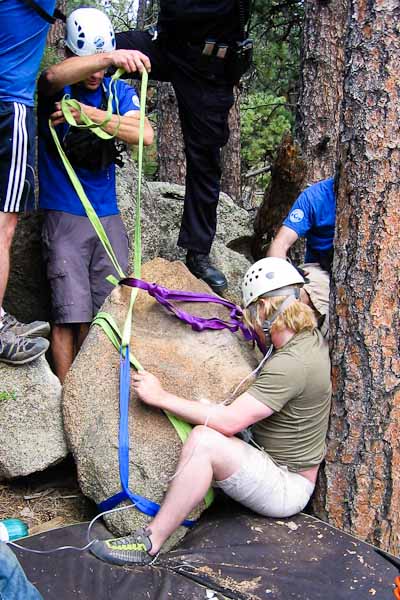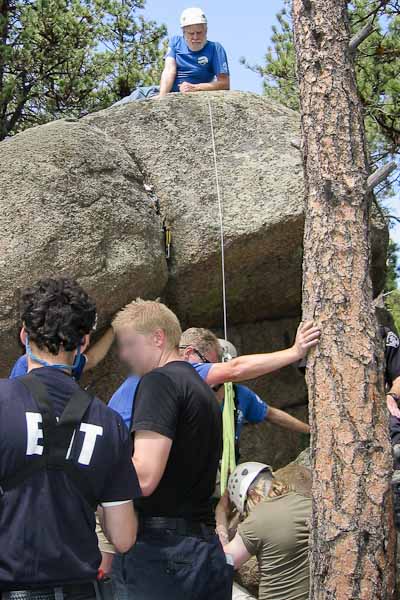3 May-2012: Rescuers rigging to lift a large boulder to
free a trapped, injured climber.
At 1:34 p.m.
Boulder County Sheriff
dispatch toned agencies for an emergency response to reports of calls for help
near
Realization Point on Flagstaff Mountain. RMRG, AMR Ambulance,
City of Boulder Open Space and Mountain Parks, Boulder City Fire Department, and
the Boulder County Sheriff's Office responded to the scene. Bystanders at the trail head
pointed in the general direction of the cries, and responders quickly
located a stuck and injured climber, pinned underneath a large boulder, a short distance north of
Flagstaff Road.
The patient had been
bouldering with a companion on a 10-12' tall boulder
and unexpectedly pulled off a large piece of it.
The climber fell backwards to the ground, and came to rest in a sitting position,
pinned against a tree, and one leg pinned between the detached piece of the boulder and another rock (photo).
The climber sustained injuries but was able to breathe normally and could not extract himself.
Upon arrival, rescuers quickly began formulating plans to move the boulder and free the injured climber.
A combination of an RMRG steel cable (lower photo) tensioned with a hand powered
rope haul system and the Boulder Fire Department's gasoline powered portable
hydraulic ram lifted the rock (photo left, wrapped with green, purple and blue webbing)
off of the patient's leg. Additional rescuers and wood cribbing were also used
to ensure the boulder did not shift and cause further injury to the patient
or rescuers as it was lifted. The multi-agency crew completed extrication at 2:47 p.m.
RMRG then performed a short
scree evacuation to
carry the patient to an awaiting ambulance for transport to Boulder Community Hospital.
20 RMRG volunteers responded to this incident. The injured climber is expected to make a full recovery.
Climbing safety discussion
Approximately 4% of climbing accidents RMRG responds to are caused by rock fall. Most
of these accidents occur February through June. Seasonal risk increase is presumably associated
with seasonal precipitation, freeze thaw cycles and climbing use patterns.
The first climbers of the season are more likely to pull off loosened rock than the last
climbers of the season. The
injured climber remarked that had he inspected of the top of the boulder problem
prior to attempting to climb it, he likely would have noticed the loose rock
hazard and avoided it. This accident occurred in a relatively low climbing use area.
Any individual climber in a low use climbing area is more likely to encounter
loose rock than an individual climber in a more popular area. In more popular climbing
areas other climbers are likely to have already released loose rock. Climbers
are well advised to be particularly alert to potential rock
fall hazards February through June. Added caution is appropriate on less
travelled rock formations or routes.








